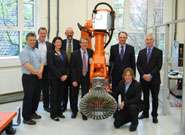Solving the problem of autonomous refuelling with robots

Robots will be used to help solve the problem of autonomous engagement for in-flight refuelling. This new research could pave the way for civil or military unmanned aerial vehicle (UAV) flights to last days or even weeks.
A relative motion robotics centre of excellence will open at the University of Bristol to research and develop an autonomous engagement solution for in-flight refuelling. Cobham Mission Equipment has commissioned the centre, as part of the ASTRAEA Autonomy and Decision Making project. The South West RDA is providing significant support to this aspect of the program.
A team of engineers from the University's Department of Aerospace Engineering and Cobham are working together to investigate and solve the challenges surrounding the "hook-up problem space", where technology will have to replicate the skills of a pilot in this challenging evolution.
This will involve the installation of two industrial robots, one track mounted, linked to a synthetic environment, to imitate the positional relationship between a tanker and receiver utilising the hose, drogue and probe refuelling system.
Dr. Tom Richardson, Lecturer in Flight Mechanics in the Department of Aerospace Engineering at Bristol University, said: "Autonomous refuelling is a key component of future UAV operations, where flights for coastal and border surveillance might be required to last days or even weeks."
Alongside this research, an advanced composite manufacturing capability using the same robotic facility will be established. The provision of such a robotics facility has been identified as a key factor for the University to advance its research on automating composites processing.
It is envisaged that this research will be performed in collaboration with its industrial partners and the wider industrial community in the South West in addition to the newly established National Composites Center.
The Relative Motion Robotics will be situated within the new Advanced Composites Centre for Innovation and Science (ACCIS), part of the University's Faculty of Engineering. The centre will be fully operational by this Autumn and in due course, will be available to the wider academic and industrial community for research within sectors such as maritime or manufacturing.
The ASTRAEA program is jointly funded by UK industry and the public sector. Its objective is to enable the routine use of Unmanned Aircraft System (UAS) in all classes of airspace without the need for restrictive or specialised conditions of operation. The aim is the development and demonstration of key technologies and operating procedures required to open up the airspace.
Mr. Richard Bourne, Program Manager Research and Technology at Cobham Mission Equipment, said: "The development of this capability at Bristol University is crucial for addressing a significant issue within the evolving UAV market. It has already established stronger ties between the Company and the University which we hope to develop further and it will also deliver a flexible capability for further broad utilisation by industry and academia."
Provided by University of Bristol










.jpg)






